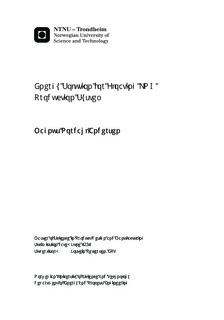Energy Solution for Floating LNG Production System
Master thesis
Permanent lenke
http://hdl.handle.net/11250/234761Utgivelsesdato
2012Metadata
Vis full innførselSamlinger
Sammendrag
This report considers different energy solutions for a floating LNG production vessel. The two alternatives analyzed are gas turbine and steam turbine. In addition to being stand-alone alternatives they are the basis for other alternatives, such as electric drive and combined cycle. Light side studies have been performed on the two latter ones. A LNG process model has been built in Aspen HYSYS, and from this several cases has been run. There are 3 levels of different parameters that have been run: 1) Energy system, 2) Feed Gas Composition, and 3) Liquefaction process. As mentioned the two energy systems are GT and ST. Three different feed gas compositions have been analyzed: 1) Low content of both CO2 and N2 (0.5 % and 1 % respectively), 2) High content of CO2 (9.5 %), and 3) High content of both CO2 and N2 (9.5 % and 3 %). The liquefaction processes analyzed are two of the most promising for a floating LNG application: Dual mixed refrigerant and dual N2 expander.The feed gas compositions was chosen to give a wide area of applications for the results, and to give illustration on how the two different energy solution would respond to changing feed gas composition. The DMR liquefaction process was chosen mainly because this is the one being implemented in Shell Prelude FLNG. Being the most proposed solution for offshore application the dual N2 expander was a natural alternative to the DMR.The analysis show a clear advantage for gas turbine and DMR process, when exclusively looking at efficiency. However; as the objective of the study states, important factors such as safety, vessel motion sensitivity, reliability, availability is also to be considered. The results show 245 kWh/ton LNG energy consumption with the DMR liquefaction process, whereas the dual N2 expander requires 424 kWh/ton LNG; over 70 % increase. However; the side- cases run in this report show advantages to the N2 dual expander in safety, weight/space requirements and ease of start-up and shut down.The ST/N2 has fuel gas consumption 4% higher than the GT/N2. On the basis of the results in this report and other studies performed on FLNG a selection of the ST/N2 setup will be favorable as long as there is a high CO2 content in the feed. With low CO2 content, hence heat demand, the advantage of the ST is smaller thanks to lower heat recovery demand.
